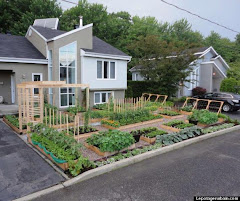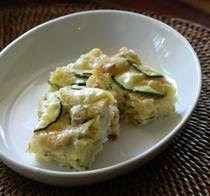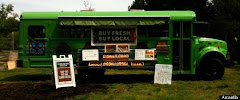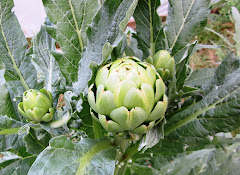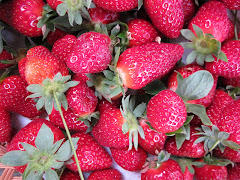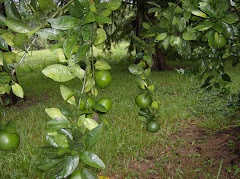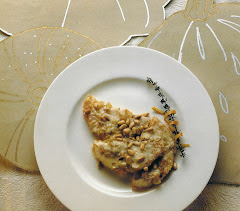 Just a picture. That is all.
Just a picture. That is all.
Friday, June 29, 2007
Wednesday, June 27, 2007
The Season Of Falling Down
 Here, we have precariously leaning sunflowers and old squash thrown to the side: a staple of every Southern garden.
Here, we have precariously leaning sunflowers and old squash thrown to the side: a staple of every Southern garden. Here we have something that has been flattened on purpose: Obviously, someone has been tromping around in the corn, tearing off ears and stomping on fallen plants. That's ok. We are pleased that the corn is 'over'.
Here we have something that has been flattened on purpose: Obviously, someone has been tromping around in the corn, tearing off ears and stomping on fallen plants. That's ok. We are pleased that the corn is 'over'. Even the flowers must fall over at some point. It's not an emergency with flowers, because there's nothing to harvest - and they are just as beautiful up or down.
Even the flowers must fall over at some point. It's not an emergency with flowers, because there's nothing to harvest - and they are just as beautiful up or down. As with any garden, things are winding down while other things are just cranking up. Although the sunflowers are on their way out, the okra is just now coming into it's own.
As with any garden, things are winding down while other things are just cranking up. Although the sunflowers are on their way out, the okra is just now coming into it's own. Once you are able to admit that you have, once again, lost control of the garden...you can at least admire the sheer wildness of the situation. The garden wrests control from you, and lives the way it wants to. You don't really want to haul out the tractor...it was so much work, after all. Let's let things be for a week or two. Fall planting is still a long way off. And there are a lot of veggies in there. What I'm trying to say is this: we have moved from wielding a big stick over orderly rows to being thankful that we are allowed to remove edible things from the craziness of the garden. Next up: melons...
Once you are able to admit that you have, once again, lost control of the garden...you can at least admire the sheer wildness of the situation. The garden wrests control from you, and lives the way it wants to. You don't really want to haul out the tractor...it was so much work, after all. Let's let things be for a week or two. Fall planting is still a long way off. And there are a lot of veggies in there. What I'm trying to say is this: we have moved from wielding a big stick over orderly rows to being thankful that we are allowed to remove edible things from the craziness of the garden. Next up: melons...
Sunday, June 24, 2007
Lock That Cat In The House!

I was on a bench by the garden, in my bathrobe, with the camera and coffee....
My mistake was letting the back screen door slam on my way out of the house.
Too late. The 'little kitty' (who really should have been assigned a better name by NOW) heard that. And the favorite place is the garden. This cat is a talker. He simply will not leave you alone when you're in the garden. He wants to talk to you (constantly) and thread his way through the rows...hiding like a panther, slinking around. Actually, if he was a panther, he'd be a very poor one, because he cannot shut up(!) AND he wants to play. AND you feel sorry for him, because after all he was tossed out of some car on a cold winter night and it took weeks to tame him and he was so very tiny. And now the adult cats really don't want to play with him. And the Crazy Cat attacks him at every opportunity. So you kind of put up with him. But my intention of taking garden pictures was sabotaged. He insisted on being in every picture.
 So here we are:
So here we are:



Friday, June 22, 2007
Bee Crossing!
Here you go!
A Bee-Crossing sign!
How cool is that?
 bee bees bees. This week was re-queening. more later.
bee bees bees. This week was re-queening. more later.Monday, June 18, 2007
Making Peppermint Tea
The Coreopsis had taken over the peppermint beds, And I didn't have the heart to pull them out, so I let them do their thing. Several years ago, we planted a row of Coreopsis in the garden, and it got six feet tall, and we even tied it up with an elaborate rope system to keep them all from falling over. It was beautiful. It will also never be necessary again. Because, since that experiment, coreopsis sproings up all over the garden every year. And in the yard, and anywhere else it can.
This year, a bunch of them popped up in the mint beds. They're just so beautiful. It's impossible to mow them down or pull them up before they've bloomed and set seed.
 Well, they did all that, and it was time to rip them out and cut back the mint, which had grown long, long trailing vines in it's efforts to reach past the coreopsis plants. I mean, how much mint could that possible be? Turns out, way, way too much to handle at one time.
Well, they did all that, and it was time to rip them out and cut back the mint, which had grown long, long trailing vines in it's efforts to reach past the coreopsis plants. I mean, how much mint could that possible be? Turns out, way, way too much to handle at one time.  I sat in the carport all day long; with the hose running and a scissors and the big mesh garden cart - cutting and washing and trimming and bagging and on and on and on. But I got it done. Then begins the drying process, whereupon I mentally thank for the billionth time my friend Maria who gave me the professional herb dryer on 'permanent loan'. With it's flat leaves, mint dries faster than many other herbs (like rosemary, for instance). But it still takes more than a day. You have to catch it between 'limp but mostly dry' - and 'so dry there's no aromatic essence left'. Then, one rack at a time (and I process about ten at a time), you must remove all of the stems, even the teeny tiny ones. That's kind of a pain, but there' no way around it. This is why dried thyme should cost a million dollars an ounce.
I sat in the carport all day long; with the hose running and a scissors and the big mesh garden cart - cutting and washing and trimming and bagging and on and on and on. But I got it done. Then begins the drying process, whereupon I mentally thank for the billionth time my friend Maria who gave me the professional herb dryer on 'permanent loan'. With it's flat leaves, mint dries faster than many other herbs (like rosemary, for instance). But it still takes more than a day. You have to catch it between 'limp but mostly dry' - and 'so dry there's no aromatic essence left'. Then, one rack at a time (and I process about ten at a time), you must remove all of the stems, even the teeny tiny ones. That's kind of a pain, but there' no way around it. This is why dried thyme should cost a million dollars an ounce. What you wind up with is a big bowl of crushed, dried, fabulous peppermint, and boy do your hands smell great, and plus your entire respiratory system is thankful. You've been inhaling mint for hours.
What you wind up with is a big bowl of crushed, dried, fabulous peppermint, and boy do your hands smell great, and plus your entire respiratory system is thankful. You've been inhaling mint for hours. Now comes the confessional part.
Now comes the confessional part.Long ago, when I first ordered teabags, I would stuff them with whatever herb I was making tea from, then sit and stare and the unsealed side of the teabag. I even sat with a friend or two and asked for advice. How do you think you're supposed to close up this side? So I would fold the edges and staple it shut. I even had those little white tags on a string. It was ok, but never looked that good (certainly not professional), and you could never really get it completely closed no matter how hard you tried. This means little scraps of tea would leak out when you put it in a cup of hot water. It was much later that, in desperation, I went looking for an answer on the internet. well. lo and behold, you're supposed to iron them shut! who knew? not me. Let me tell you. This is a great trick. Actually, it's not a trick. It's the way it's supposed to be done.
 So there you have it.
So there you have it.

A little bit of 'packaging ingenuity', and you have teabags to sell in the market tent. Also, a jar of teabags for your own self. yes. It Is A Lot Of Trouble, all told. But, everybody spends their time doing Something. And I can think of a lot of other things I would rather not be doing. It's worth every step.
Monday, June 11, 2007
the 'Any Minute Now ' Edition
 But the real surprise are the ANY MINUTE NOW vegetables: Corn, tomatoes, and melons...
But the real surprise are the ANY MINUTE NOW vegetables: Corn, tomatoes, and melons...

 and then there are the BEES! We did want bees, and by god we have them now. They are everywhere. Not just in the garden, of course. They do so love the lemon balm flowers. I need to cut them back, but I was in the garden early on Saturday. Early, but not early enough. I will have to sneak out at 6 a.m. (they do sleep in just a little). Or wait until 8 at night, when they go home. I'm not just fighting them in the squash row anymore.
and then there are the BEES! We did want bees, and by god we have them now. They are everywhere. Not just in the garden, of course. They do so love the lemon balm flowers. I need to cut them back, but I was in the garden early on Saturday. Early, but not early enough. I will have to sneak out at 6 a.m. (they do sleep in just a little). Or wait until 8 at night, when they go home. I'm not just fighting them in the squash row anymore.In the meantime, I have learned that if you want to hose down the patio, you'd better do it in a hurry, because once the bees find out you're spraying water all over the place, they run over there. They do love (and need) water.
Tuesday, June 05, 2007

No time lately for new pictures or tirades or cute postings; we have been working hard, as we always do in the early days of June. Hose-dragging, vegetable-picking, mowing time is here with a vengeance. Last week I was amused at my early attempts to beat the heat. This week, it is not a joke. You know, all year long I look forward to green beans. What a fantasy! Green beans are a wonderful thing, no doubt. But after a week or so of trying to keep them picked, you are thinking how wonderful it would be to just plow them under (!) That may sound evil, and I'm sure all of you would love to have some fresh organic green beans. But as I write this, there is a 75 ft. row out there that would take a single person most of one day to pick. I kid you not.

The yellow beans have been equally prolific this year. I actually sent out an 'emergency!' to our email list on Sunday due to yellow bean excess. By the end of the day, much of the row had been picked by hearty individuals who showed up and thought it was not so bad out there at noon (!) well, more power to them. The effort is worth it to most folks. The beans are indeed very wonderful. But enough of bean talk.
This morning, I was tasked with picking the yellow squash first...and that seems an innocent piece of work. We don't even have a whole row. We were trying to be conservative...and smart. I mean, how much squash can one garden really have before it's a joke? I waded in there with a knife. It's not so bad if you wear gloves. Smarter if you have long sleeves, which I didn't. But I moved slowly, because the new bees think the squash belongs to them, not to me. And they are fighting over each and every squash blossom. If you take your time, they can't figure out what the heck is annoying them (and it's you).
 If you look closely, you can see that there are three or more bees in this flower. I'll show them, though. I;m going out in the morning to pick these precious flowers. We'll make stuffed (and fried) squash blossoms for dinner.
If you look closely, you can see that there are three or more bees in this flower. I'll show them, though. I;m going out in the morning to pick these precious flowers. We'll make stuffed (and fried) squash blossoms for dinner.
About Our CSA
We are entering the sixth season of our CSA (Community Support Agriculture). What began as an experiment for the creative marketing of our produce has developed into a fulfilling experience for us and our members, one that we so look forward to each year. What you will find below is an explanation of how we operate the CSA, the cost, length of season, expected commitment, etc. We ask that you read it carefully before responding. We have dedicated members that stay on year after year, but for a number of folks, it is challenging to come out every Saturday for nine weeks running and to have time to participate. For those who love the quality of the vegetables, herbs, and flowers – and who like the experience of planting, harvesting, and interacting with others who have the same likes, it is a very rewarding experience. Please read on…
What is Community Supported Agriculture? (CSA)
Community supported agriculture is a movement that got its start in this country in the mid-1980’s, driven by a desire by neighborhood groups to re-connect with local growers and producers. The CSA movement is enjoying increasing popularity and availability with each passing year. The goal of CSA is to involve the vegetable-eating-public more intimately with “their” farm. Why do I use “their” in that description? Because in CSA, members buy a share of the farm which, in effect, provides them an ownership stake in the vegetables produced. In that respect, the farmer and consumer become partners. There are many benefits from this relationship to the farmer and consumer alike. For the farmer, it provides a guarantee of sales so he can plant to supply his contract. It also minimizes the time required to market the produce, freeing him up for what he does best, which is…farm. For the consumer, it guarantees a steady supply of farm fresh produce for a fixed price, encouraging healthy eating, and promoting a sense of participation and community around the farm that has been long lost in the age of industrial agriculture. For both the farmer and consumer, it promotes a bond based on trust and mutual interest. For those interested in information on CSA and farms that have set up these systems, the web has worlds of information available with a simple word search.
Why did Port Hudson Organics decided to become Port Hudson CSA?
For most of you who have spent any time visiting our farm and talking with us, you are aware that Thais and I both work full time, maintaining our little farm, bee hives, yard, and other farm-related activities in our “spare” time. This means that virtually every waking hour that we are not at work you would find us in the field or manning the produce tent (or carport). As we expanded our farm-related enterprises to areas such as biodiesel, berries and bee hives, the farm demands finally exceeded our available time. So in 2009, in order to continue our farm sustainability effort and reduce our time commitment (primarily the time spent selling), we tried a concept that is becoming increasingly popular across the country in the “Eat fresh, Eat local” movement, that is, the CSA farm. In the spring of 2009, we enrolled (what ended up to be) 25 CSA member families, and were blown-away by the success of the venture. Member enthusiasm, assistance, and clear appreciation for the unsurpassed quality of our produce resulted in an excellent experience for everyone involved. Since then, we have expanded our enrollment to approximately 40 member families, which is a comfortable carrying capacity of our one acre garden. At this point in our lives, with regular jobs and other commitments, we have no plans to expand further.
What kind of vegetables are grown and how are they distributed?
We grow a wide variety of Spring and Summer vegetables (generally about 20 different varieties). At any time during the season, you can expect around 12-15 different offerings, and 6-8 culinary herbs. We also grow cut flowers, usually zinnias and sunflowers. Each week members will receive a selection list by email. Members then make 7 selections of vegetables and 2 selections of herbs from the list. Members can check off their first and second preferences and we will make every effort to supply the members with their selected items. In cases where we are short on a particular item, say, yellow squash, we will substitute another available vegetable (for example, zucchini) from member’s second choice selection if at all possible. Members are free to make notes on their list if there is a particular vegetable they do not want (for example, zucchini) and we will try to honor their request. The amounts (pounds or numbers) of vegetables or herbs per selection were based on an approximation of equal value based on the prices we have charged for these items in the past. And as last year’s members know, the amounts of produce on the list are the minimum amount you will receive. Often, when there is a surplus beyond what has been selected, we will throw in some “lagniappe”. Members should note that there are a couple of exceptions on the selection list: a bouquet of flowers, when available, counts as two selections from the herb list; similarly, watermelon, when available, counts as two selections from the vegetable list. Each week, a basket with all of your produce and herbs will be made up with your list attached. Blank lists will be available for you to fill out for the following week, as the mix of produce and herbs change with the weather.
Can I select more than one of a particular item?
Yes, if you want 6 pounds of tomatoes one week, you can simply put the number “3” next to the selection “2 lbs. tomatoes” on your sheet and pick four other vegetable selections to make a total of seven selections. If we have enough tomatoes to satisfy your request, we will provide that amount. If we are short, we will attempt to at least provide you with one selection of tomatoes and make up the rest of your basket with other choices. We will let members know each week which vegetables we expect to have in abundance. For example, due to space considerations, we have limited plantings of corn and each planting is generally available for only one Saturday, so we will be encouraging members to select as much corn as they can from the list on the weeks that corn becomes available (we try to send out weekly emails on the state of the farm). Of course, members will also be given preference for the purchase of additional vegetables if, for example, you want to freeze a bushel of corn when it comes in and there is surplus available.
How will the CSA Baskets be distributed?
Members choose to come to the farm either Friday evening or Saturday morning each week during the season. Once you arrive, you can choose from a variety of garden activities in progress and lend a hand. This can range from planting and/or picking vegetables; washing, weighing, and bundling produce; cutting and arranging flowers; cutting and separating herbs to order; helping to pack baskets with weekly selections; sitting under a tree with other members and stripping beans off of plants. Occasionally there is a bigger project at hand, such as erecting the cucumber fence or helping to mulch rows with hay. There will be weeks when you are not able to help due to your schedule, but we find that most of our members help out almost every week. The process takes about an hour, and when you leave you bring your weekly basket with you. Many find this outdoor activity in the garden a respite from their work week in an office!
Members are asked to pick up their CSA baskets each Saturday by 10:00 AM. This is probably the biggest commitment you will make as part of the CSA. We understand that it may be difficult to come every Saturday for 9 weeks, but there are a couple of strategies you can employ to make this easier. (1) you can buddy-up with one or more members in your area and go on alternate Saturdays, each delivering or holding the other’s basket for pick up at their house; (2) you can send a family member or close friend; or (3) you can come Friday afternoon to help with the harvest and bring your basket home with you then (we had a lot of members take this option, as we do a lot of harvesting on Friday in advance of the Saturday bedlam).
What if you have a crop failure or natural disaster?
A CSA is a partnership between the farmer and the consumer, and within this partnership is an understanding of shared risk. That said, we do not expect members to bear the full cost of a catastrophic failure, nor have we ever experienced a completely failed season. Should the worst happen, members will be reimbursed a portion of their investment and we will do all in our power to make it right with members through a combination of refunds and discounts on following seasons.
What time commitment is asked as part of the CSA?
CSAs, by definition, include member support. Each week, literally hundreds of pounds of produce must be harvested, hundreds of bunches of herbs must be clipped and tied, and dozens of flower bouquets must be picked. Without member support, this is logistically impossible for part time farmers. Hence, we ask members to commit to help in some fashion (picking, sorting, filling orders, etc) according to their abilities every other weekend or so (we are not rigid on this). We have found that members enjoy becoming involved in the process. Learning about how food is grown and harvested is an uplifting and educational experience. After all, that is why we do it. And it is an integral part of CSA farms across the country. We are assuming that you found us because you appreciate this connection, and we hope that you can find the small amount of time to required to experience that connection.
What is the cost?
Cost of the CSA membership is $350. This covers 9 weeks of farm fresh vegetables, herbs, and flowers of your choice. This comes out to about $38 per week, probably more than you would pay at the grocery store for conventionally-grown produce, but less than you would pay for organic produce at Whole Foods. The quality of the produce, however, cannot be approached by any supermarket, and the experience is priceless. Also, membership in the CSA includes a pint of our farm honey when it becomes available.
In Summary
So that about covers it. If you want to experience first hand the pleasures of seeing, smelling, picking and eating truly wholesome food, please respond quickly to this email. We would appreciate some information on you and your family, and why you want to join the CSA. We will let you know within a few days, and will ask for payment at that time. We ask that you understand that we have about twice as many families on the waiting list as we have openings. However, if you do not make in into the CSA this year, we will give you first shot at joining next year if you are still interested.
Thank you so much for your interest in our little farm. We hope to see you this spring.
Will & Thais Perkins
Port Hudson Organics CSA


